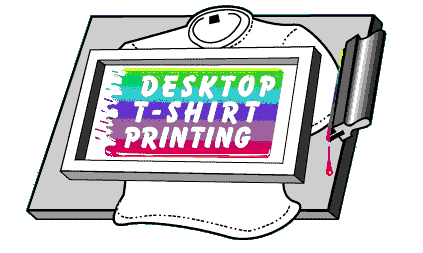This site consists of five loosly linked pages focused on fabric screenprinting as a takeoff for some design issues, for example the relationship between the t-shirt and the allover print, which are two entirely different kinds of repeats; in addition I'll discuss the extremely useful interface between screenprinting and computers. Twenty years ago the fabric printing industry was compelled for environmental reasons to stop using solvent-based colors. What resulted from this shift was a class of water-based printing inks that are safe, easy to use and don`t require much equipment. This site is about printing t-shirts, but there's an underlying agenda: "you can do this in your garage, or on your kitchen table!" Silkscreen is both a commercial and an art medium: T-shirts are usually
printed in large quantities on machines, but they always retain their expressive
potential, which can be especially wide-ranging because they're a good medium for
both words and pictures. Screenprinting has an elegant interface with the computer because both mediums present information on a grid, and like the computer screenprinting is very proceedural, A, thenB, thenC.(A lot of people abandon the medium because some disaster like ink drying in the screen begins to seem unavoidable, whereas just as in cooking--another proceedural science--often it's just a timely stir that keeps the sauce from burning).
Silkscreen is an excellent method for depositing a uniform layer of color on a surface: the thickness of the mesh--it's a material similar to a teastrainer or a screen door--regulates the thickness of the pool of ink that's left when the screen comes off. It's useful to consider that the squeegee passing over the fabric is filling the voids between the threads with ink rather than pushing it through: visualise the ink being pulled through by surface tension, or by of the absorbency of the substrate (an industry word for for the stuff being printed). The process is probably a direct descendent of the paper cutout dye-application technique still practiced in Japan, which came to depend on more and more complex bridges of pasted-on human hairs and later--silk strands to hold the delicate structures together. At some point it occurred to someone to attach the stencil to fabric rather than laboriously building up mesh on the stencil. |


